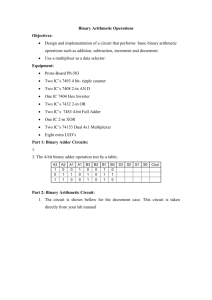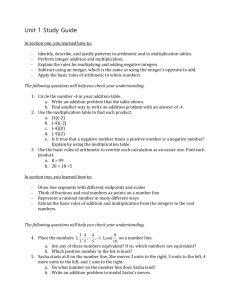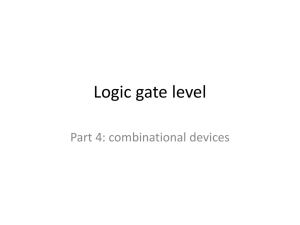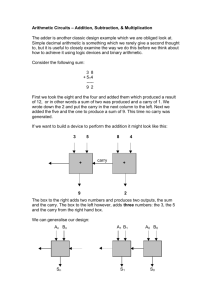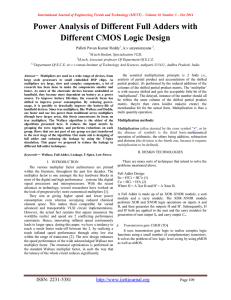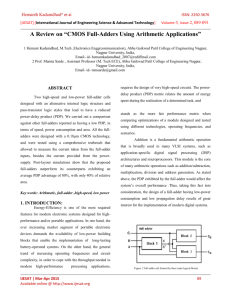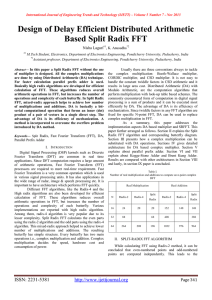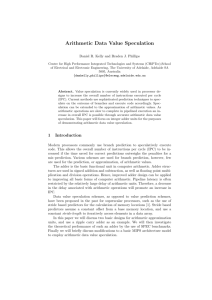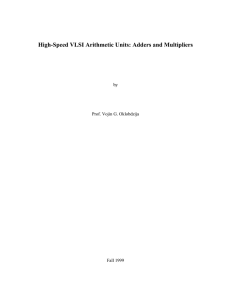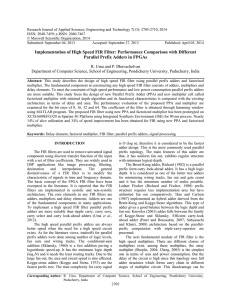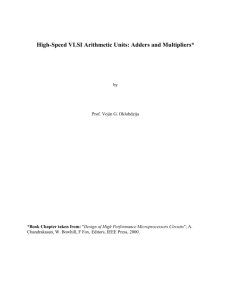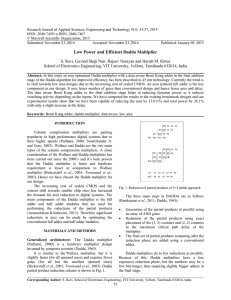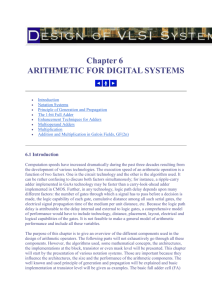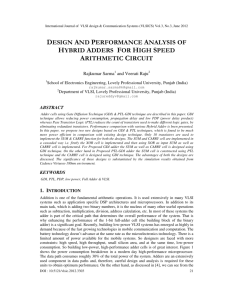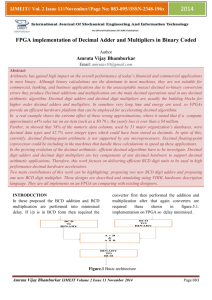ECE 621 - California State University, Northridge
advertisement
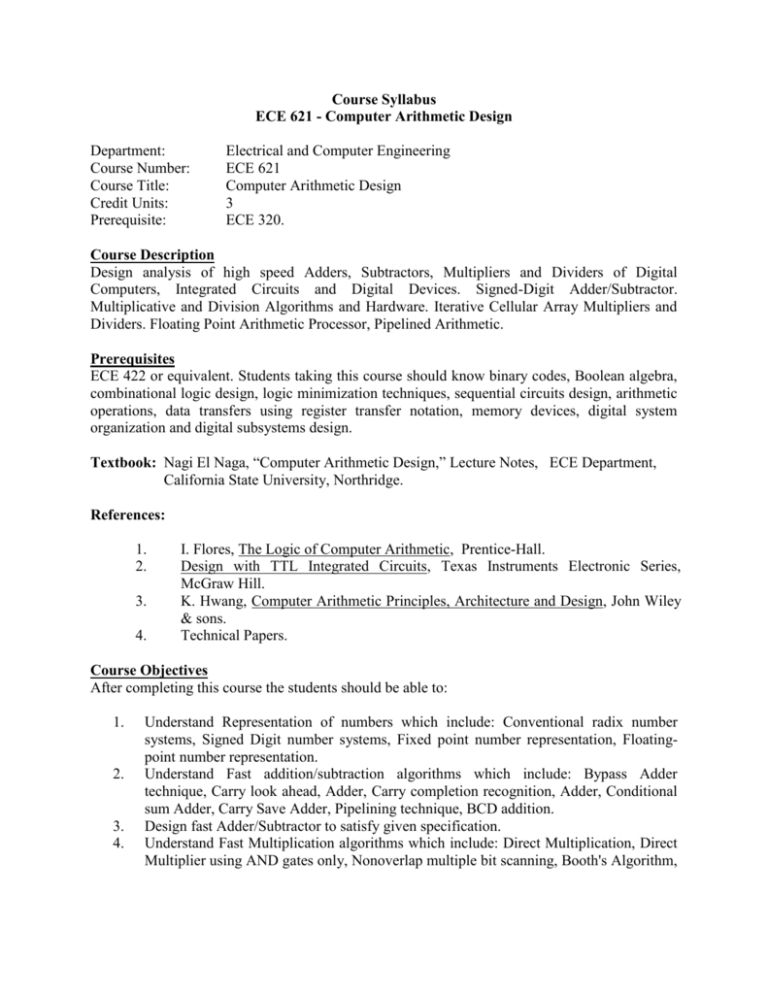
Course Syllabus ECE 621 - Computer Arithmetic Design Department: Course Number: Course Title: Credit Units: Prerequisite: Electrical and Computer Engineering ECE 621 Computer Arithmetic Design 3 ECE 320. Course Description Design analysis of high speed Adders, Subtractors, Multipliers and Dividers of Digital Computers, Integrated Circuits and Digital Devices. Signed-Digit Adder/Subtractor. Multiplicative and Division Algorithms and Hardware. Iterative Cellular Array Multipliers and Dividers. Floating Point Arithmetic Processor, Pipelined Arithmetic. Prerequisites ECE 422 or equivalent. Students taking this course should know binary codes, Boolean algebra, combinational logic design, logic minimization techniques, sequential circuits design, arithmetic operations, data transfers using register transfer notation, memory devices, digital system organization and digital subsystems design. Textbook: Nagi El Naga, “Computer Arithmetic Design,” Lecture Notes, ECE Department, California State University, Northridge. References: 1. 2. 3. 4. I. Flores, The Logic of Computer Arithmetic, Prentice-Hall. Design with TTL Integrated Circuits, Texas Instruments Electronic Series, McGraw Hill. K. Hwang, Computer Arithmetic Principles, Architecture and Design, John Wiley & sons. Technical Papers. Course Objectives After completing this course the students should be able to: 1. 2. 3. 4. Understand Representation of numbers which include: Conventional radix number systems, Signed Digit number systems, Fixed point number representation, Floatingpoint number representation. Understand Fast addition/subtraction algorithms which include: Bypass Adder technique, Carry look ahead, Adder, Carry completion recognition, Adder, Conditional sum Adder, Carry Save Adder, Pipelining technique, BCD addition. Design fast Adder/Subtractor to satisfy given specification. Understand Fast Multiplication algorithms which include: Direct Multiplication, Direct Multiplier using AND gates only, Nonoverlap multiple bit scanning, Booth's Algorithm, 5. 6. 6. 7. Recoded Multipliers, Multiplication Using Carry Save Adders, Modular Multiplication and Wallace Tree, Cellular Array Multipliers Design fast Multiplier to satisfy given specification. Understand Binary Division algorithms which include: Comparison method, Restoring method, Non-restoring method and SRT Division. Design fast Divider to satisfy given specification. Design fast ALU to satisfy given specification. Topics Covered/Course Outline The following are detailed contents of the course: 1. Switching theory review a. Functional simplification and implementation b. Universal Logic Modul ( ULM ) 2. Representation of numbers a. Conventional radix number systems b. Signed Digit number systems c. Signed number representations d. Fixed point number representation e. Floating-point number representation 3. Fast addition/subtraction a. Bypass Adder technique b. Carry look ahead, Adder c. Carry completion recognition, Adder d. Conditional sum Adder e. Carry Save Adder f. Pipelining technique g. BCD addition 4. Binary Multiplication a. Direct Multiplication b. Direct Multiplier using AND gates only c. Nonoverlap multiple bit scanning d. Booth's Algorithm e. Recoded Multipliers f. Multiplication Using Carry Save Adders g. Modular Multiplication and Wallace Tree h. Cellular Array Multipliers 5. Binary Division a. Comparison method b. Restoring method c. Non-restoring method 6. Cellular Logic (cellular and iterative arrays) 7. Rate multiplier 8. Computational errors 9. Reliability of systems Relationships to Program Outcomes This course supports the achievement of the following outcomes: a) Ability to apply knowledge of advanced principles to the analysis of electrical and computer engineering problems. b) Ability to apply knowledge of advanced techniques to the design of electrical and computer engineering systems. c) Ability to apply the appropriate industry practices, emerging technologies, state-of-theart design techniques, software tools, and research methods for solving electrical and computer engineering problems. d) Ability to use the appropriate state-of-the-art engineering references and resources, including IEEE research journals and industry publications, needed to find the best solutions to electrical and computer engineering problems. e) Ability to communicate clearly and use the appropriate medium, including written, oral, and electronic methods. f) Ability to maintain life-long learning and continue to be motivated to learn new subjects. g) Ability to learn new subjects that are required to solve problems in industry without being dependent on a classroom environment. h) Ability to be competitive in the engineering job market or be admitted to an excellent Ph.D. program. Prepared by: Nagi El Naga Febraury, 2003



